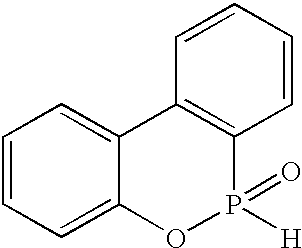Halogen-free phosphorous-containing flame-resistant epoxy resin compositions
a flame-resistant epoxy resin and phosphorous-containing technology, which is applied in the direction of plastic/resin/waxes insulators, applications, other domestic articles, etc., can solve the problems of damage and failure during manufacturing, the requirement of heat distortion becomes especially important, and the shelf life of pre-pregs must be sufficiently long
- Summary
- Abstract
- Description
- Claims
- Application Information
AI Technical Summary
Benefits of technology
Problems solved by technology
Method used
Image
Examples
example 1
A resin system was prepared by mixing the following ingredients at room temperature into methyl ethylketone in order to get a 60 wt % solution:
EPON 164 epoxy resin (derived from ortho cresol novolak (39 wt % relative to the weight of all dissolved components);
EXOLIT OP910 (10 wt %, a phosphor compound according to formula (2), wherein R.sub.2 =CH.sub.3 of CLARIANT);
HIRETAR 101 powder (6 wt %, a phosphor compound according to formula (1) of Schill und Seilacher);
ATO SMA EF30 (45 wt %, a compound according to formula (5) of Elf Atochem); and
2-methylimidazole in a 10 wt % solution in methyl proxitol was mixed in about 30 minutes with the obtained solution up to a total concentration of 0.04 wt % relative to the weight of non-solvent ingredients, before impregnation.
A standard glass cloth (7628 style, 200 g / m.sup.2, epoxy silane finished) of 20 cm.times.20 cm, was impregnated with the resin solution by hand.
The impregnated fabric was cured in a forced air circulated oven at 170.degree. ...
PUM
| Property | Measurement | Unit |
|---|---|---|
| temperatures | aaaaa | aaaaa |
| glass transition temperature Tg | aaaaa | aaaaa |
| glass transition temperature Tg | aaaaa | aaaaa |
Abstract
Description
Claims
Application Information
 Login to View More
Login to View More - R&D
- Intellectual Property
- Life Sciences
- Materials
- Tech Scout
- Unparalleled Data Quality
- Higher Quality Content
- 60% Fewer Hallucinations
Browse by: Latest US Patents, China's latest patents, Technical Efficacy Thesaurus, Application Domain, Technology Topic, Popular Technical Reports.
© 2025 PatSnap. All rights reserved.Legal|Privacy policy|Modern Slavery Act Transparency Statement|Sitemap|About US| Contact US: help@patsnap.com



